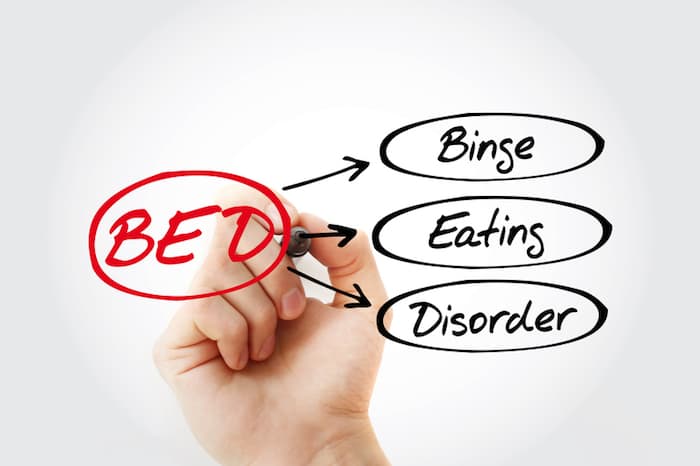- Calls to this hotline are currently being directed to Within Health, Fay or Eating Disorder Solutions
- Representatives are standing by 24/7 to help answer your questions
- All calls are confidential and HIPAA compliant
- There is no obligation or cost to call
- Eating Disorder Hope does not receive any commissions or fees dependent upon which provider you select
- Additional treatment providers are located on our directory or samhsa.gov
What is Binge Eating Disorder: Symptoms, Risks, & Causes
Binge Eating Disorder (BED) has been discussed as a disordered eating behavior since the 1950’s but was not officially recognized as its own diagnosis until the Diagnostic and Statistical Manual of Mental Disorders published its 5th Edition (DSM-5) in 2013. Even so, this is not an indicator of the severity or prevalence of BED throughout history. In fact, BED disorder is the most common eating disorder in the United States, therefore, awareness of signs, symptoms, and treatment interventions is important.
Advertisement
Binge Eating Disorder Definition
An episode of binge eating is described as eating an atypically large amount of food in a short period of time while feeling of loss of control during the episode and immense shame and guilt afterward. Binge eating disorder may also be commonly referred to as Compulsive overeating disorder, or Night Eating Syndrome (NES), though the terms have slightly different criteria.
Binge Eating Disorder DSM-5 Criteria
The DSM-5 specifies diagnostic criteria that one must meet for a full diagnosis of a mental disorder. For BED, the following criteria are required for diagnosis:
- Recurrent episodes of binge eating, which are characterized by BOTH of the following
- “Eating, in a discrete period of time (e.g. within any 2-hour period), an amount of food that is definitely larger than what most people would eat in a similar period of time under similar circumstances.
- A sense of lack of control over eating during the episode (e.g. a feeling that one cannot stop eating or control what or how much one is eating).
- The binge-eating episodes are associated with three (or more) of the following:
- Eating much more rapidly than normal.
- Eating until feeling uncomfortably full.
- Eating large amounts of food when not feeling physically hungry.
- Eating alone because of feeling embarrassed by how much one is eating.
- Feeling disgusted with oneself, depressed, or very guilty afterward.
- Marked distress regarding binge eating is present.
- The binge eating occurs, on average, at least once a week for 3 months.
- The binge eating is not associated with the recurrent use of inappropriate compensatory behavior as in bulimia nervosa and does not occur exclusively during the course of bulimia nervosa or anorexia nervosa [1].”

ICD-10 Code for BED
The International Classification of Disease (ICD-10) codes allow professionals worldwide to identify or communicate a diagnosis regardless of differences in diagnostic terminology from culture to culture.
For BED, the ICD-10 code is F50.81.
Binge Eating Disorder Statistics
Binge eating disorder is frighteningly common in Westernized cultures, as many engage in binge eating behaviors but minimize these as “emotional eating” or falsely consider them as effective coping mechanisms.
Below are some important factors about BED prevalence and impact provided by the NIH’s National Institute on Mental Health [2] [3]:
- 1.2% of adults in the US struggle with BED disorder.
- BED is two times more prevalent in females (1.6%) than males (0.8%).
- Research indicates that 62.6% of those with BED experience impairment in their daily lives and 18.5% experience severe impairment.
- 78.9% of those with BED experience a comorbid mental health diagnosis.
- BED often co-occurs with anxiety, mood, impulse control, and substance use disorders.
- 43.6% of individuals with BED seek treatment, with more women seeking out treatment than men.
- 1.6% of teenagers struggle with BED.
- BED impacts African Americans as often as white individuals, however, more research is needed on its impact among other racial and ethnic groups.
What Is Another Name for Binge Eating Disorder?
As mentioned above, there are numerous alternative understandings or terms for binge eating behaviors, however, it is important to know the difference between these terms and a BED disorder diagnosis.
Compulsive Overeating
Compulsive overeating is a term more commonly used to refer to Binge Eating Disorder. While the two are incredibly similar, there is one big difference – severity. Individuals with BED have met the diagnostic criteria specified above for a full diagnosis. Those that experience Compulsive Overeating may engage in bingeing behaviors of BED frequently, however, not enough to meet the full criteria for a BED diagnosis. Diagnostically, compulsive overeating would be referred to as OSFED, Other Specified Feeding and Eating Disorders. This does not mean the behaviors of excessive eating are any less concerning, however.
Night Eating Syndrome (NES)
Night Eating Syndrome (NES), involves “recurrent episodes of night eating, as manifested by eating after awakening from sleep or by excessive food consumption after the evening meal [1].” The DSM-5 also specifies that “there is awareness and recall of the eating” and that “the night eating is not better explained by external influences such as changes in the individual’s sleep-wake cycle or by local social norms [1].”
NES is specified in the DSM-5 under OSFED categories of disordered eating and differs from BED in that individuals with NES present with less shape/weight concerns as well as reduced disinhibition and depressive symptoms [4]. Additionally, individuals with NES tended to eat less during the day than those with BED [4].
Binge Eating Disorder Symptoms
With the prevalence of BED being so high and continuing to increase, it is important to have an awareness of signs and symptoms to support patients or loved ones should they begin to struggle.
Physical Signs of Binge Eating Disorder
BED can be difficult to identify, as the resultant shame and guilt of binge episodes lead to secrecy. If you observe some of the below symptoms in a loved one or patient, consider them to be red flags and do not be afraid to ask more questions.
- Eating unusually large amounts of food in a specific amount of time.
- Eating when one is not hungry or full.
- Eating at a fast pace.
- Eating alone or in secret.
- Hiding food.
- Eating until uncomfortably full.
- Reporting feelings of guilt or shame around eating.
- “Frequently dieting, possibly without weight loss [5].”
- Loss of sexual desire.
- Weight fluctuation.
- Reported feelings of low self-worth.
The journey of recovery is a continuous process and there is a lot you can do to help yourself outside of the therapist’s office or within a treatment program. Because the process of recovering from an eating disorder is often strenuous, it is critical to develop effectual self-help skills. Learning how to cope in positive ways and efficiently manage your emotions will be valuable tools in maintaining your recovery. At Eating Disorder Hope, we recognize the importance of having the ability to self-help, so we have complied resources that will encourage you to grow in this area.

Anxiety, Depression, & Other Co-Occurring Disorders
78.9% of those with BED experience a co-occurring diagnosis, as BED behaviors can be a maladaptive coping skill or increase symptoms of other mental disorders such as depression or anxiety.
Anxiety Disorders: Many individuals that struggle with clinical anxiety present with disordered relationships to food. This could be a result of using food to cope with emotional dysregulation. It is also likely that the opposite is true and that the shame, guilt, secrecy, and feelings of loss of control that occur with binge eating result in increased anxiety symptoms.
Mood Disorders: Mood disorders, such as Major Depressive Disorder or Bipolar Disorder, are experienced by 46.4% of those with a BED diagnosis. This is unsurprising, as, similar to anxiety disorders, many individuals seek to cope with uncomfortable emotional states using food. This correlation may also occur due to an individual’s self-view and self-worth being impacted by their binge eating behaviors. Binge eating episodes can also lead to feelings of hopelessness or despair as one feels they cannot control their behaviors.
Other Co-Occurring Diagnosis: The relationship between BED and other diagnoses are similar to those with mood and anxiety disorders, with the disorders fueling one another. Some other disorders that commonly co-occur with BED include impulse control disorders and substance use disorders.
Get Treatment Online
Binge Eating Disorder Health Risks
The impacts that consistent binge eating episodes can have on physical health long-term are concerning.
Many may discount binge eating behaviors as “emotional eating,” however, if left untreated, they can be incredibly dangerous and lead to the following:
- Obesity
- High cholesterol
- High blood pressure
- Diabetes
- Cardiovascular issues
- Arthritis
- Gallbladder disease
- Increased risk of some types of cancer.

What Causes Binge Eating?
As with most mental disorders, there is not one specific cause of Binge Eating Disorder. There are many psychological, social, and biological factors that can contribute to BED development. For example, negative affect is commonly associated with BED, leading many researchers and professionals to believe that “binge-eating episodes are triggered by negative affect and provide relief from them [6].” Individuals that struggle with emotion regulation and emotional awareness also appear to have an increased likelihood of BED behaviors [6]. Interpersonal and social issues can also result in BED diagnoses. Further, research seems to clearly indicate a relationship between reward sensitivity as well as impulsivity, making one more susceptible to BED behaviors.
Binge Eating Disorder Treatment
Treatment for BED can be crucial in reducing the lifetime prevalence of the disorder, that is, reducing the likelihood one will struggle with BED behaviors for their lifetime.
As with most eating disorders, the number one, evidence-based treatment recommended is Cognitive Behavioral Therapy (CBT). One study notes that “CBT has higher abstinence, is well-tolerated, and maintains remission for 1 or 2 years [6]. CBT focuses on the impact that beliefs and thoughts have on subsequent feelings and behaviors, encouraging individuals to alter their core beliefs and thoughts in a way that then alters their behaviors.
Dialectical Behavior Therapy (DBT) is also recommended, as it was created for individuals that struggle with emotion regulation, which is also correlated with BED. DBT focuses on how one can regulate their emotional states, tolerate distress, exist within the present moment, and communicate needs to others. All of these skills work effectively to reduce BED symptoms as well as the symptoms of disorders that often co-occur with BED.
Regardless of the theoretical orientation to treatment, the key is to receive treatment at all. Of course, be a conscious consumer and do not be afraid to ask your treatment team if they are using the most up-to-date, evidence-based treatments and, if they are not, why they are not. Even so, the likelihood of individual achieving remission of BED symptoms and recovery increases with any type of mental health treatment.
Do not be afraid to seek out support, be an advocate in your treatment, and fight for a future free from BED.
Webinar: Understanding the Facts About Binge Eating Disorder
Presented by: Allan S Kaplan MD MSc FRCP(C) is currently a Senior Clinician/Scientist, Chief of Research at the Center for Addiction and Mental Health in Toronto, and Vice-Chair for Research and Professor in the Department of Psychiatry, University of Toronto. He is also Director of the Institute of Medical Science, School of Graduate Studies, Faculty of Medicine. He was the inaugural Loretta Anne Rogers Chair in Eating Disorders at Toronto General Hospital and is currently Senior Scientist, Toronto General Research Institute. He received his medical, psychiatric, and graduate school training at the University of Toronto. He has worked in the field of eating disorders for 30 years, has lectured widely on various topics in the field, published 150 peer-reviewed articles, two books, 50 book chapters, and over 200 abstracts. He is the Past President of both the Academy for Eating Disorders, the largest organization of eating disorder professionals in the world and the International Eating Disorder Research Society. He has been a continuously funded peer-reviewed investigator since 1992 and has received grant support from the National Institute of Mental Health in the USA and the Canadian Institutes of Health Research in Canada.
There are also three types of therapy that can be especially helpful in the treatment of BED. These therapies are:
- Cognitive-behavioral therapy (CBT): A type of therapy aimed at helping individuals understand the thoughts and feelings that influence their behaviors.
- Interpersonal psychotherapy (IPT): A form of therapy in which the focus is on an individual’s relationships with family members and peers and the way they see themselves
- Dialectical Behavior Therapy (DBT): A type of therapy that focuses on teaching individuals skills to cope with stress and regulate emotions
The journey of recovery is a continuous process and there is a lot you can do to help yourself outside of the therapist’s office or within a treatment program. Because the process of recovering from an eating disorder is often strenuous, it is critical to develop effectual self-help skills. Learning how to cope in positive ways and efficiently manage your emotions will be valuable tools in maintaining your recovery. At Eating Disorder Hope, we recognize the importance of having the ability to self-help, so we have complied resources that will encourage you to grow in this area.
In addition to these methods, group therapy sessions led by a trained eating disorder therapist, as well as eating disorder support groups, may also be effective methods of establishing recovery from BED.
Resources
- American Psychiatric Association. (2013). Diagnostic and statistical manual of mental disorders (5th ed.).
- Unknown (2017). Eating Disorders. The National Institute of Mental Health. Retrieved from https://www.nimh.nih.gov/health/statistics/eating-disorders.
- Unknown (2016). Definition and facts for binge eating disorder. National Institute of Health. Retrieved from https://www.niddk.nih.gov/health-information/weight-management/binge-eating-disorder/definition-facts.
- Allison, K. C., Grilo, C. M., Masheb, R. M., & Stunkard, A. J. (2005). Binge eating disorder and night eating syndrome: a comparative study of disordered eating. Journal of Consulting and Clinical Psychology; 73(6), 1107–1115.
- Unknown (2016). Eating disorders. The National Institute of Mental Health, Retrieved from https://www.nimh.nih.gov/health/topics/eating-disorders/.
- Iqbal, A., Rehman, A. (2021). Binge eating disorder. StatPearls. Retrieved from https://www.ncbi.nlm.nih.gov/books/NBK551700/.
Author
Publish Date:
Last Updated:
Page Last Updated and Reviewed By: Jacquelyn Ekern, MS, LPC on August 16, 2019



